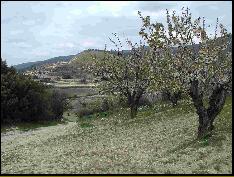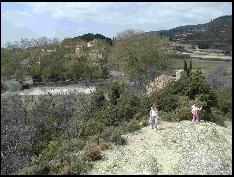


Walking
The Luberon Parc, stretching roughly from Cavaillon to Manosque, is a great area for hiking or just a casual stroll. Cucuron is an excellent base for a walking holiday.
Nature trails laid out by the Luberon Regional Natural Park: a botanical trail in the Cedar Forest , the Ochre Trail in Roussillon, the "Between Town and Hillsides" Trail in Cavaillon,the Conservatory of Terraced Crops in Goult.
There are more than 4000 km of marked paths over hill and mountain in the Vaucluse region. There are the shorter hiking paths, and "grande randonnée (GR)" are bigger hiking paths which criss-cross Vaucluse, through the wine country, and even an entire loop around Vaucluse. GR97 passes through Cucuron. You will find details and maps covering local walks at Le Point.
Cucuron is also now the centre of a new wine trail.
Cycling
This is also good mountain biking and general cycling country - the Luberon Parc site has examples of routes:
Bicycle hire is available locally from:
en.rentbikescooterluberon.com/bike-rental/
Swimming
There are facilities for adults and children to swim in the nearby Etang de la Bonde (2.5 miles) plus swimming pools at Pertuis (8 miles). The coast (Cassis) is about a 50 minute drive.
Tennis
There are three tennis courts available for hire in the village.
Canoeing
The nearby Durance river is popular for both canoeing and kayaking.
Riding
There is good horseriding in the area and a number of riding schools nearby including one in Cucuron ("Les Cavaliers du Luberon" - Le Vabre Tél 04 90 77 22 19). There are around thirty farms in Camargue that rent out horses by the hour, half-day or day. The tourist office in Stes-Maries has a complete list (PROMENADE A CHEVAL).
Climbing
Buoux (about 10 miles away) is famous for its technical slab climbing on steep compact limestone (grades 4a-8c).
Festivals and Events
There are many cultural events throughout the year in Provence. For a current selection of local festivals try www.provenceweb.fr/e/specials.htm
The 'provenceguide' site (in English and French) for the Vaucluse area has detail of events in the area.
Sightseeing options
For some itinerary ideas try the South of France Tourist board www.visit-southern-france.com.
Villages nearby:
Vaugines A pleasant 3km walk from Cucuron. This quiet village was chosen as the setting for the famous French films "Jean de Florette" and "Manon des Sources", adapted from books written by thc Provençal author Marccl Pagnol, and starring Yves Montand. The pictures above were taken en-route to Vaugines in Spring.
Ansouis With its beautiful medieval (12th, c.) castle which can be visited even though privately owned. Inside the castle of Ansouis is a magnificent collection of 17th and 18thc. furniture as well as splendid tapestries.
Lourmarin 6km from Cucuron and listed as "one of the most beautiful villages in France", Lourmarin’s many cafes, restaurants & boutiques attract many visitors in Summer.
Bonnieux - Built on a plateau above the valley, Bonnieux is one of the finest villages in the area with plenty to see.
Buoux The small village of Buoux is a short drive to the north east of Cucuron among the rolling hills in the heart of the Parc Naturel Régional du Luberon it is a popular place for climbers from around the world.
Apt Apt is a small town a short drive north through the Luberon hills and is well known for its candied fruit and the famous market on Saturday morning at the Place des Martyrs de la Résistance
Roussillon Situated in the heart of one of the biggest ochre deposits in the world, Roussillon is famous for its magnificent red cliffs and ochre quarries
Some popular sights
Abbaye du Senanque outside Gordes, is a lovely religious site and the place to see Provence's famed lavender fields. The best time to visit the Abbaye de Sénanque is in July and August, when the sea of lavender surrounding the abbey is in full bloom.
Lacoste is a very picturesque medieval village, well worth seeing, perched on the east end of a mountain spine rising up out of the plains between the Plateau de Vaucluse to the north and the Luberon to the south. The old village sits on a ridge, facing Bonnieux across the lower farmlands to the east. At the top of the village is the medieval looking ruins of the infamous Marquis de Sade's castle.
Isle-sur-Sorgue is known as the antiques capital of France. Antique lovers and art collectors will be gratified by the nearly 300 permanent antique dealers and second hand shops here. L'Isle sur la Sorgue hosts antiques' fairs at Easter and over the August 15th holiday. More than 500 antique dealers and second hand dealers gather here to show their treasures to customers from all over the world. The Sunday morning market is worth a trip.
Fontaine de Vaucluse is where a deep spring feeds the Sorgue river. 'Fontaine' means 'fountain' and Vaucluse is the name of the department of France you are in.
Mont Ventoux The giant of Provence and the last Alpine mountain ridge before the Rhône plain, the Mont Ventoux can be seen almost from everywhere in Provence . It can be cold at the top even in summer. One of the most notorius stages of the Tour de France and robably the second most famous climb in the world after the Alpe d'Huez, the Mont Ventoux is a magnet for cyclists throughout the summer.
Sightseeing beyond the Luberon
Aix-en-Provence is around 35 km away and a lovely city to wander around, particularly on market day (Tuesday, Thursday, Saturday 9am to 12:30) when it is full of colour and noise. Cezanne's studio is a popular place to visit for those interested in art. As a city of art and culture Aix possesses a wealth of superbe architecture that has been carefully preserved and restored. Walking through the Cours Mirabeau and the Rue Gaston de Saporta one can admire the private mansions with their sculptured doors and windows and the intricate iron work on the balconies. Discerning shoppers choose the elegant boutiques in the quartier Mazarin.
Link to guide to Aix in English www.aixenprovencetourism.com
Arles is about an hour's drive from Cucuron. The town dates back to the 7th century BC, and was a major Gallo-Roman city. The major Roman sites, such as the Arena and the Theater, are unique in that they are integrated into the houses and buildings of the town. The streets of the town are narrow and winding.
Avignon about and hour's drive from Cucuron, is a place to take your time wandering around the streets. The theater festival has made Avignon important in modern times. Started in 1947 by Jean Vilar, every year between the 10th of July and the 5th of August.
Les-Baux-de-Provence just over an hour driving west, is well worth a visit. The town dates back to the 7th century BC, and was a major Gallo-Roman city. The major Roman sites, such as the Arena and the Theater, are unique in that they are integrated into the houses and buildings of the town. Les-Baux-de-Provence is a touristic site rather than an active village, but that's not a discredit considering the beauty of the village and the surrounding Alpilles. Our girls enjoy exploring the village and it caters well for children.
The Camargue is well worth a day out - a nature reserve of birds, white horses and black bulls as well as rice paddies and salt plains. Horse riding is a popular past time ad there are several places you can call in and ride.
The Cote d'Azur or French Riviera is a day-trip away. St Tropez is 1.5 hours, set on the blue waters of the Golfe de Saint-Tropez, this modern version of a medieval town is most popular for the line of luxury yachts in her harbour and the facing line of terrace cafés, divided by a parade of strolling tourists and slowly cruising sports cars. Night life is very lively and often one can see helicopters bringing elegant guests to private parties, in one of the many luxurious villas in the bay. "People watching" is a favourite sport in Saint-Tropez in the summer. Visitors like to sit in the outdoor cafés, hoping either to be seen or to see someone else.
Cannes is 2 hours away by road, it is one of the best-known cities of the French Riviera, famous for the glitzy hotels, cars, beaches, and visitors.
Nice and Monte Carlo 2.5 hours, both needing at least a day to visit and perhaps best seen incorporating a stopover as there is so much to see.
Canyon du Verdon, is a spectacular canyon that forms a border between the Alpes-de-Haute-Provence and the Var. Up to 700 m deep, the 21-km-long canyon varies in width between 6 and 100 m at the bottom and 200 to 1500 m at its rim.
Marseille 1 hour away, must be the seafood capital of Provence, at least. The most famous seafood dish of Marseilles is bouillabaisse, world renowned and worth the reputation.
Just off the coast, near Toulon, Porquerolles is situed on the same parallel as the Cape of Corsica, and that
makes it the most extreme southern tip of the Provencal Coast. With its 3000
acres Porquerolles is the largest of the three islands. It forms an arc
stretching from West to East and it is 7 km long , 3 km wide and 142 meters
high.
In 1988 the island was put under the protection of the French National Trust (National Park). The sandy beaches and superb views from the cliffs( on the south side) falling to a sparkling sea, attract many visitors who enjoy walking or biking. The temperate climate adds its own special charm to each season of the year.